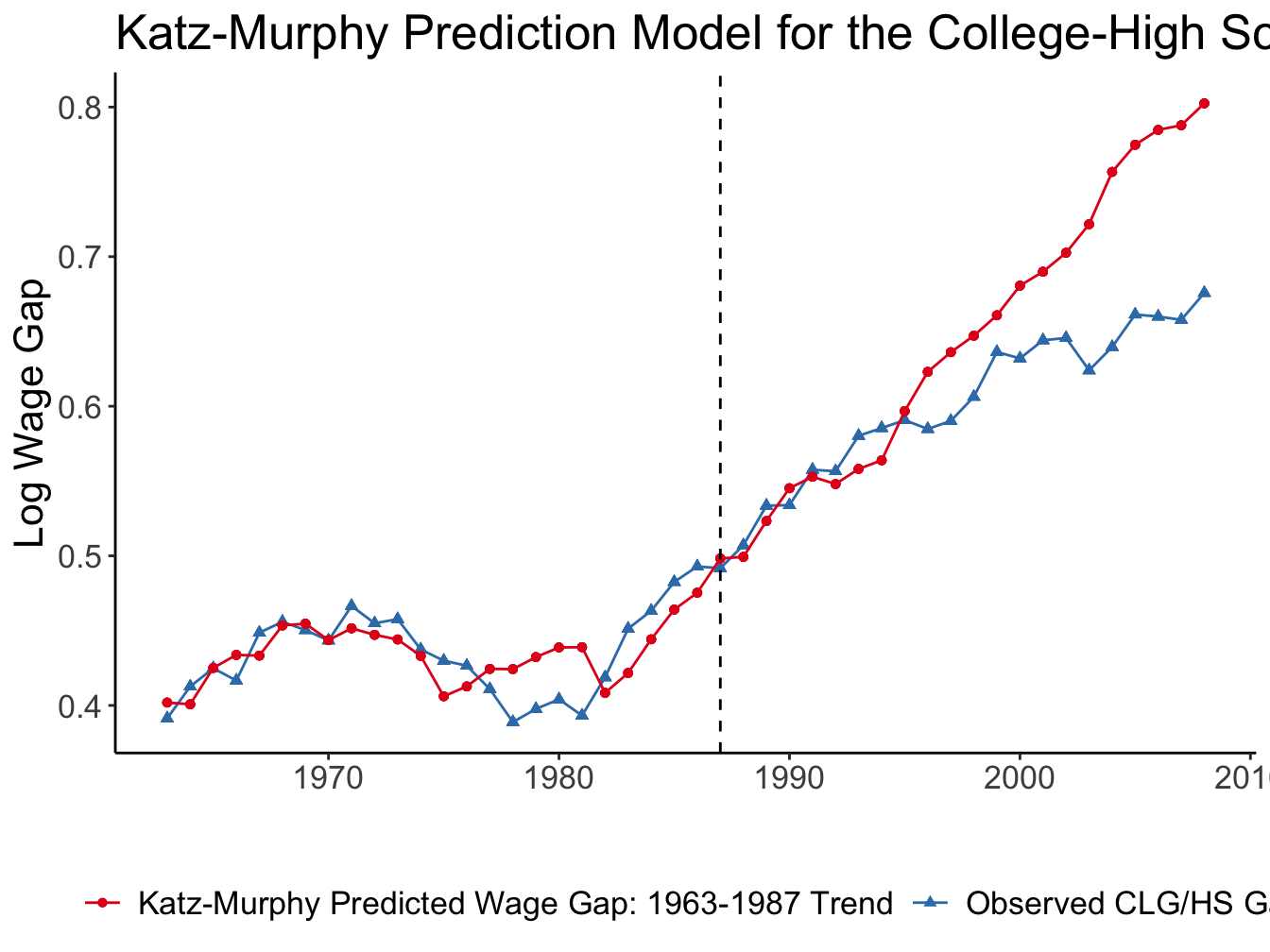
8. Technological shift and labour markets
KAT.TAL.322 Advanced Course in Labour Economics
Technological shift and the labour market
This lecture is based on Acemoglu and Autor (2011)
Stylised facts
Labour market of educated workers
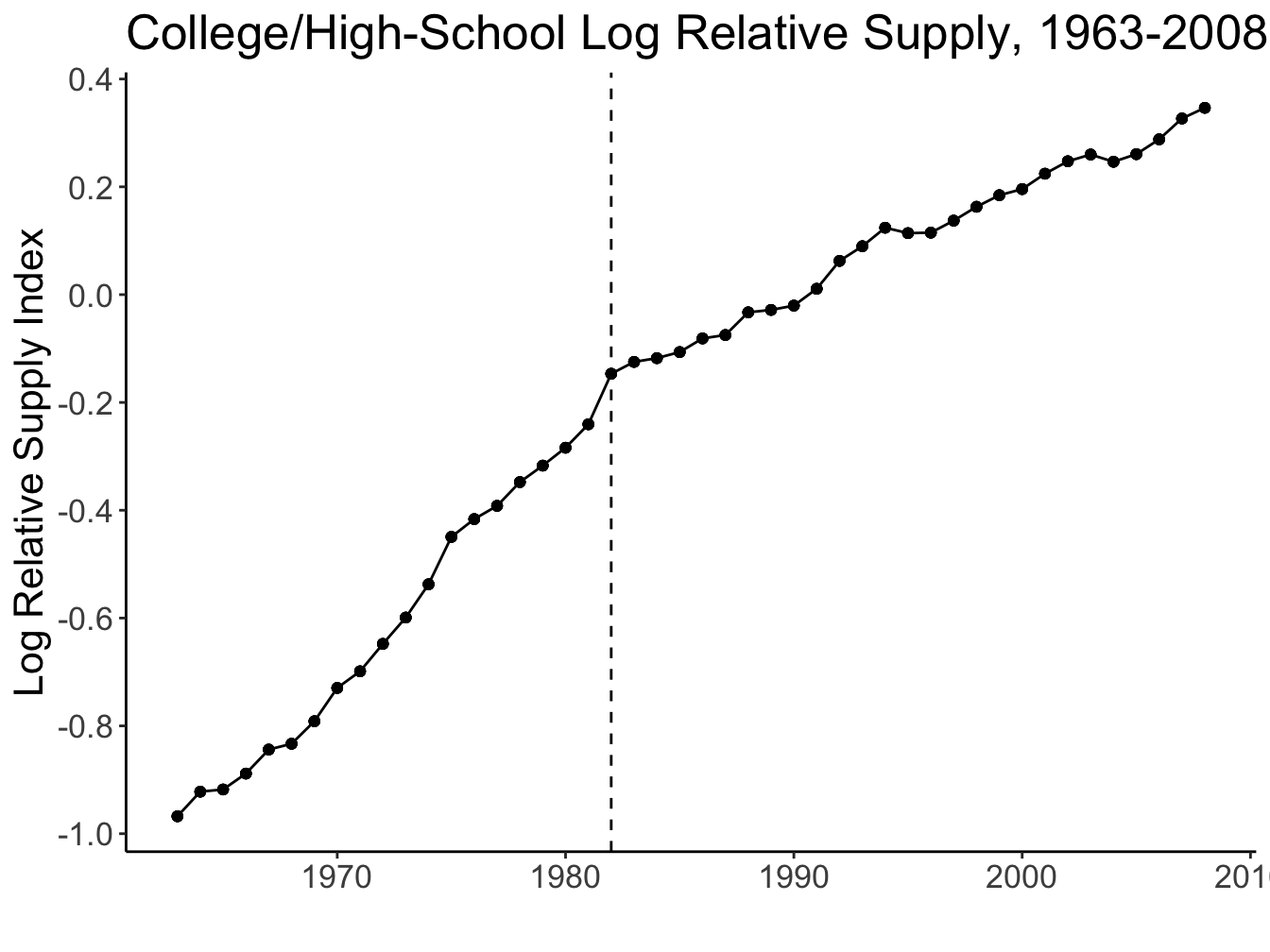
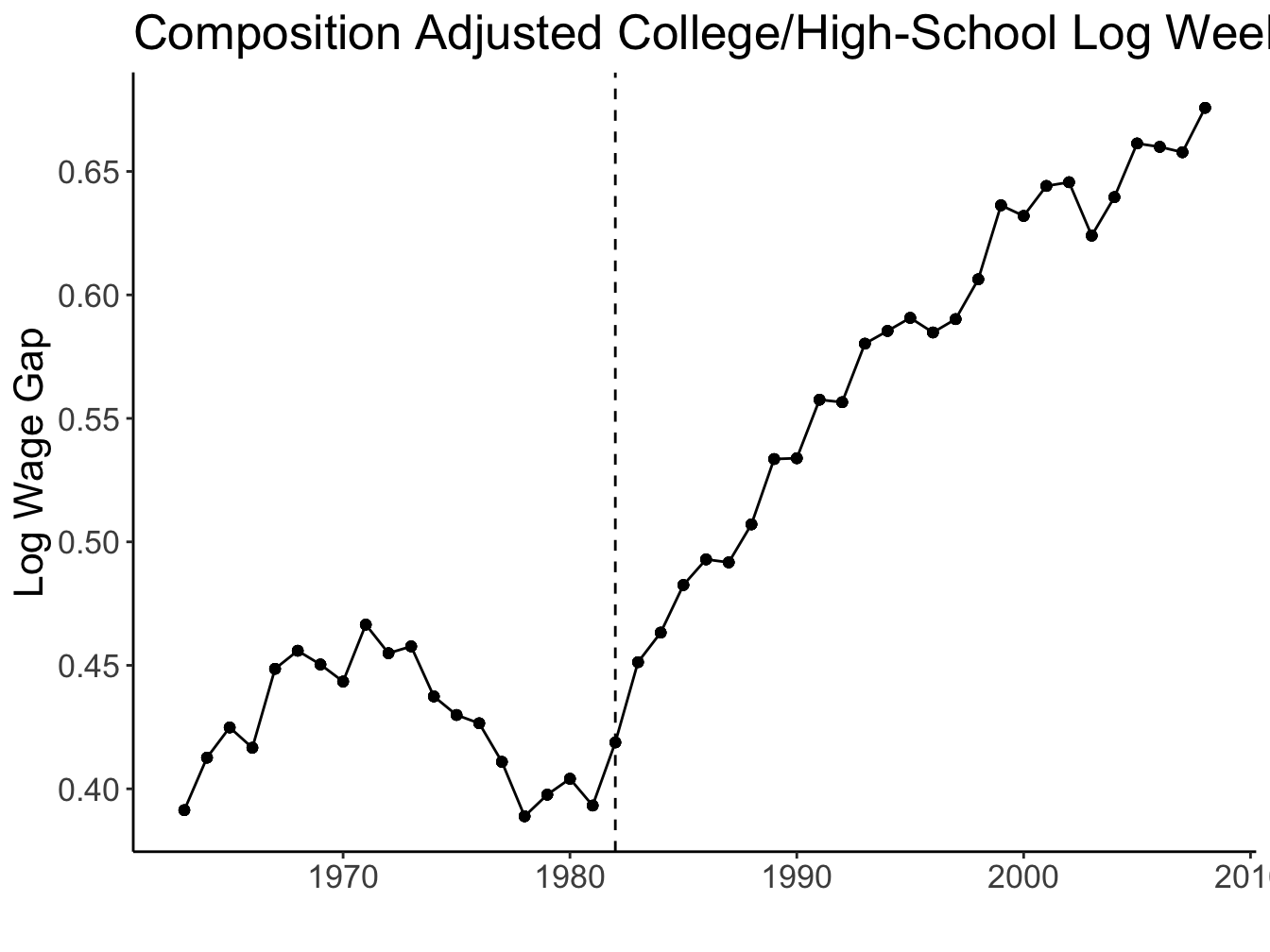
Source: Figures 1 and 2 (Acemoglu and Autor 2011)
Labour supply of educated workers grew faster than that of uneducated workers. Contrary to the predictions of standard labour supply and demand theories, the relative wages of educated workers were also growing since the 1980s.
This is typically attributed to technological shift that also increased demand for educated workers.
In this lecture we will study both canonical models of skill-biased technological change and more recent task-based models that allow us to study the question of labour displacement.
Canonical model
Canonical model
Overview
Two types of labour: high- and low-skill
Typically, high edu and low edu (can be relaxed)Skill-biased technological change (SBTC)
New technology disproportionatelyHigh- and low-skill are imperfectly substitutable
Typically, CES production function with elasticity of substitutionCompetitive labour market
Canonical model
Production function
We consider production function that only depends on labour input. However, we now differentiate between two types of labour: high-skill
Technological changes do not directly replace skills, it simply makes one type of labour more or less productive.
So, the trends in the labour market over the past decades could be described with
It is straightforward to assume that firms would want to shift their production to exploit the greater productivity of the high-skilled labour.
However, in perfectly competitive labour markets also wages
Canonical model
Rationalisation of CES production function
- Single output
- Two goods
- Combination of the 1. and 2.
Supply of
There are several rationalisations for the choice of the CES production function.
- There is single output
- There are in fact two goods
- A combination of the two. There are, in fact, two goods
Also it is important to note that in this model the supply of labour by different types is assumed inelastic. Therefore, it is sufficient to study only the firm behaviour. However, this will only render partial results and full analysis would require us to also consider labour supply and human capital investment decisions.
Canonical model
Equilibrium wages
Comparative statics:
You can verify that profit-maximising firm will choose labour demand
You can also verify the simple comparative statics.
- Wages of the low-type
- Wages of the high-type
- Both wages are increasing in their respective productivities. If workers become more productive, their wages rise correspondingly in a perfect competition environment.
Canonical model
Tinbergen’s race in the data
Katz and Murphy (1992)
The log-equation of skill premium is extremely attractive for empirical analysis
Assume a log-linear trend in relative productivities
and plug it into the log skill premium equation:
We can use the expression for the skill premium to estimate the parameters in the data. After taking logs on both sides and assuming log-linear trend in innovation, we can express log skill premium as a function of time trend
We can use time-series data from the labour markets to estimate the regression and back out
Tinbergen’s race in the data
Katz and Murphy (1992)
Estimated the skill premium equation using the US data in 1963-87
Implies elasticity of substitution
Agrees with other estimates that place
Tinbergen’s race in the data
Very close fit up to mid-1990s, diverge later
Fit up to 2008 implies
Accounting for divergence:
non-linear time trend in
bringsdifferentiate labour by age/experience as well
Using the estimated regression, we can also plot the predicted and observed skill premium over time. The red curve corresponds to predicted skill premium from the estimation based on 1963-1987. The vertical red line marks the end of the estimation period. So, we can see that observed and predicted skill gap are very close to each both in- and out-of sample until mid-1990s. But the series start diverging from early 2000s.
If the entire period until 2008 is used for estimation, then the implied
The divergence can be explained in the context of the canonical model in two ways.
- Technological progress is non-linear and started to decelerate in 2000s. While the idea of non-linear technological progress can be sensible, it is hard to believe that it slowed down in the last three decades! So, it is not a reasonable explanation for the flattening of the skill premium.
- Relative supply of skilled labour has changed. In the model we assumed the supply doesn’t change. Obivously, in real life, it also responds to market incentives and policy changes. The aggregate relative supply of college-educated workers increased over time, but it might have happened heterogeneously in different experience groups. For example, there were fewer men getting college degree after the end of Vietnam war, which shows up as lower relative supply of experienced college-educated workers twenty years later. Therefore, Acemoglu and Autor (2011) estimate the skill premium regression with aggregate and experience-group-specific labour supply. This helps improve the fit for the entire period.
Canonical model
Summary
- Simple link between wage structure and technological change
- Attractive explanation for college/no college wage inequality1
- Average wages
However, the model cannot explain other trends observed in the data:
- Falling
- Earnings polarization
- Job polarization
Also silent about endogeneous adoption or labour-replacing technology.
Unexplained trend: falling real wages
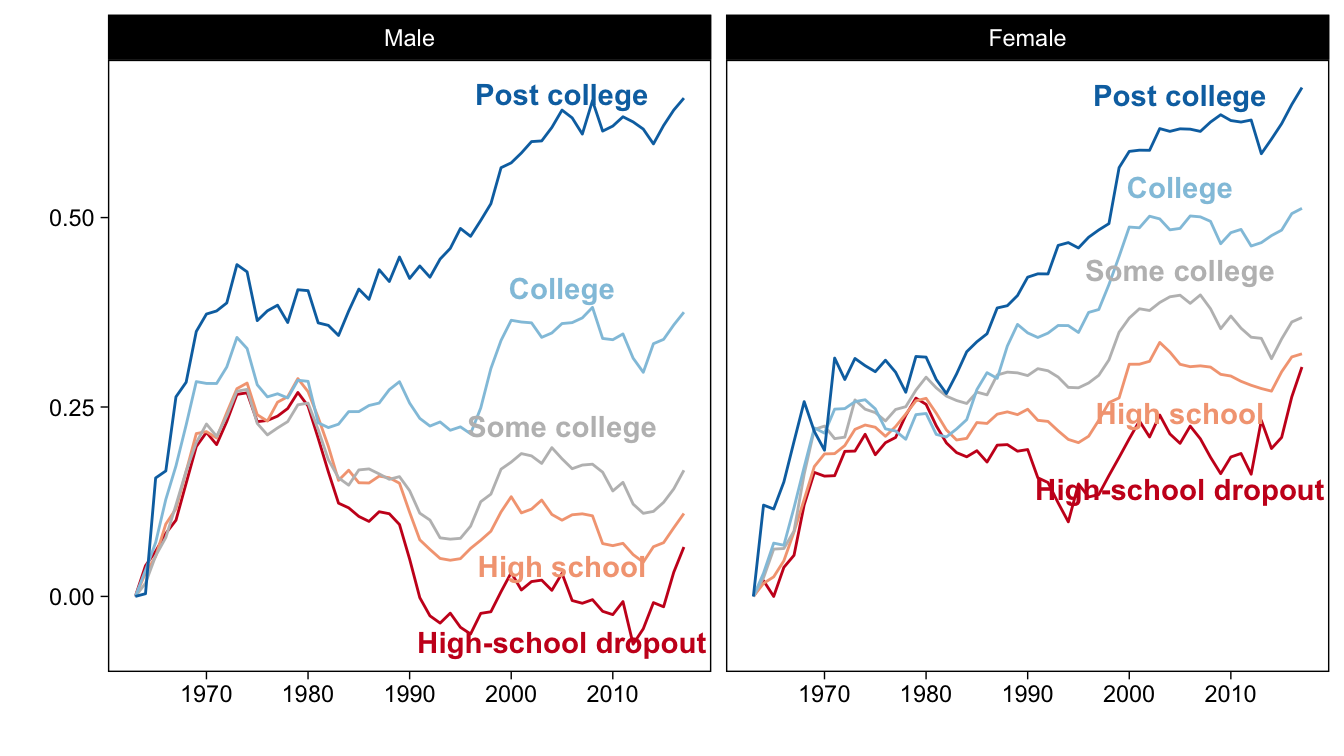
The skill premium in wage can increase because either
- wage level of high-skill workers rise, or
- wage level of low-skill workers fall, or
- both.
The figure above shows that infact the rising skill premia is the combination of the two: the wage level of college-educated workers rose, while that of high-school dropouts fell over time.
If we go back to the comparative statics of wage levels, we can see that the only way
Both of these are hard to believe in. We have explicitly shown that
Therefore, we must conclude that the canonical model does not fit all the data patterns and that we need a different type of model.
Unexplained trend: earnings polarization
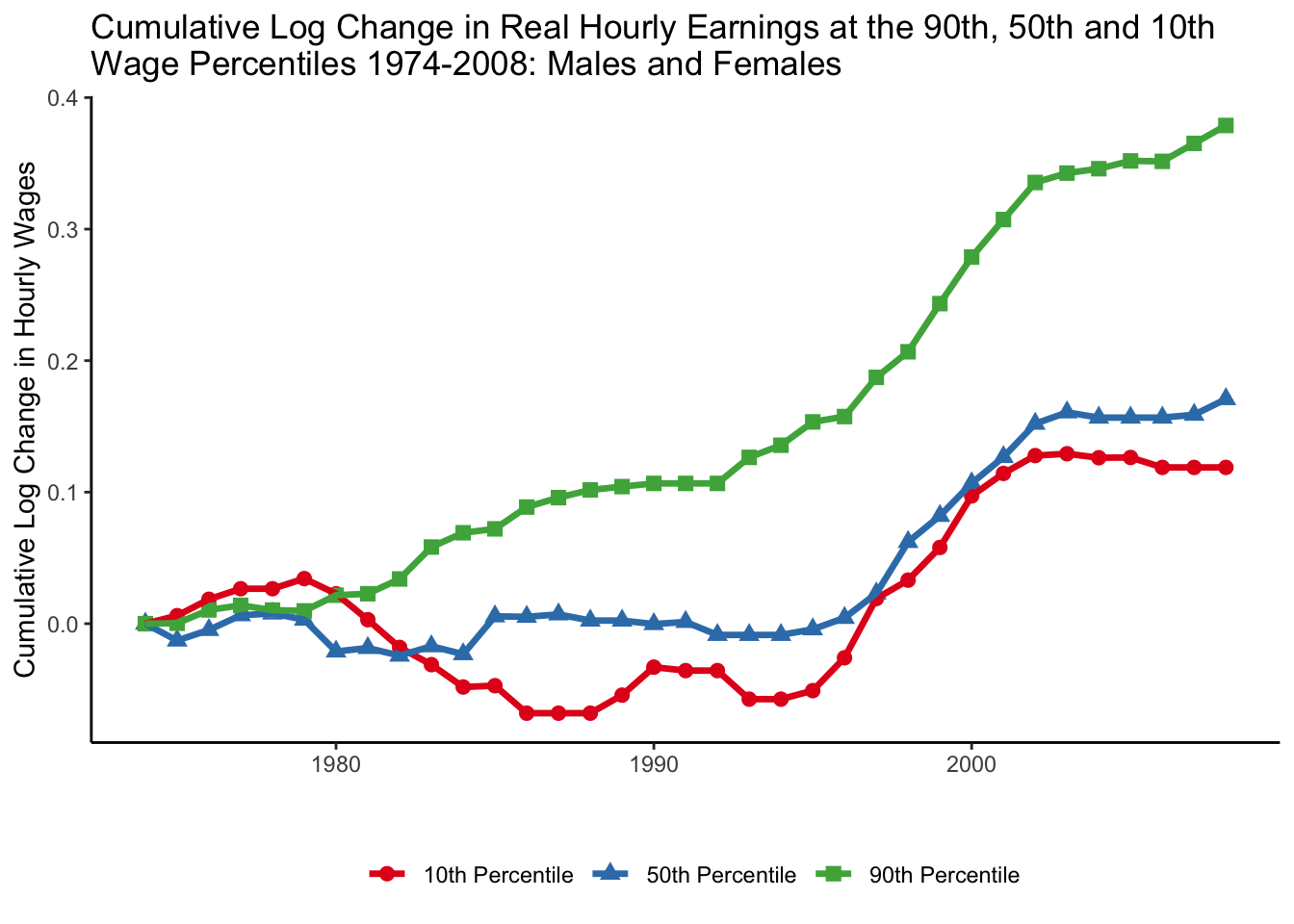
The canonical model can explain between group inequality, like college vs non-college workers (
The figure above shows the evolution of log hourly earnings at the bottom (10th percentile), middle (50th percentile) and top (90th percentile) of the earnings distribution. We can see that earnings at the top were growing much faster than the rest of the distribution. Earnings in the middle remained roughly flat until the 2000s and earnings at the bottom had brief period of reduction in the 1980s. These trends suggest that also inequality within groups might have evolved in different ways.
Unexplained trend: job polarization
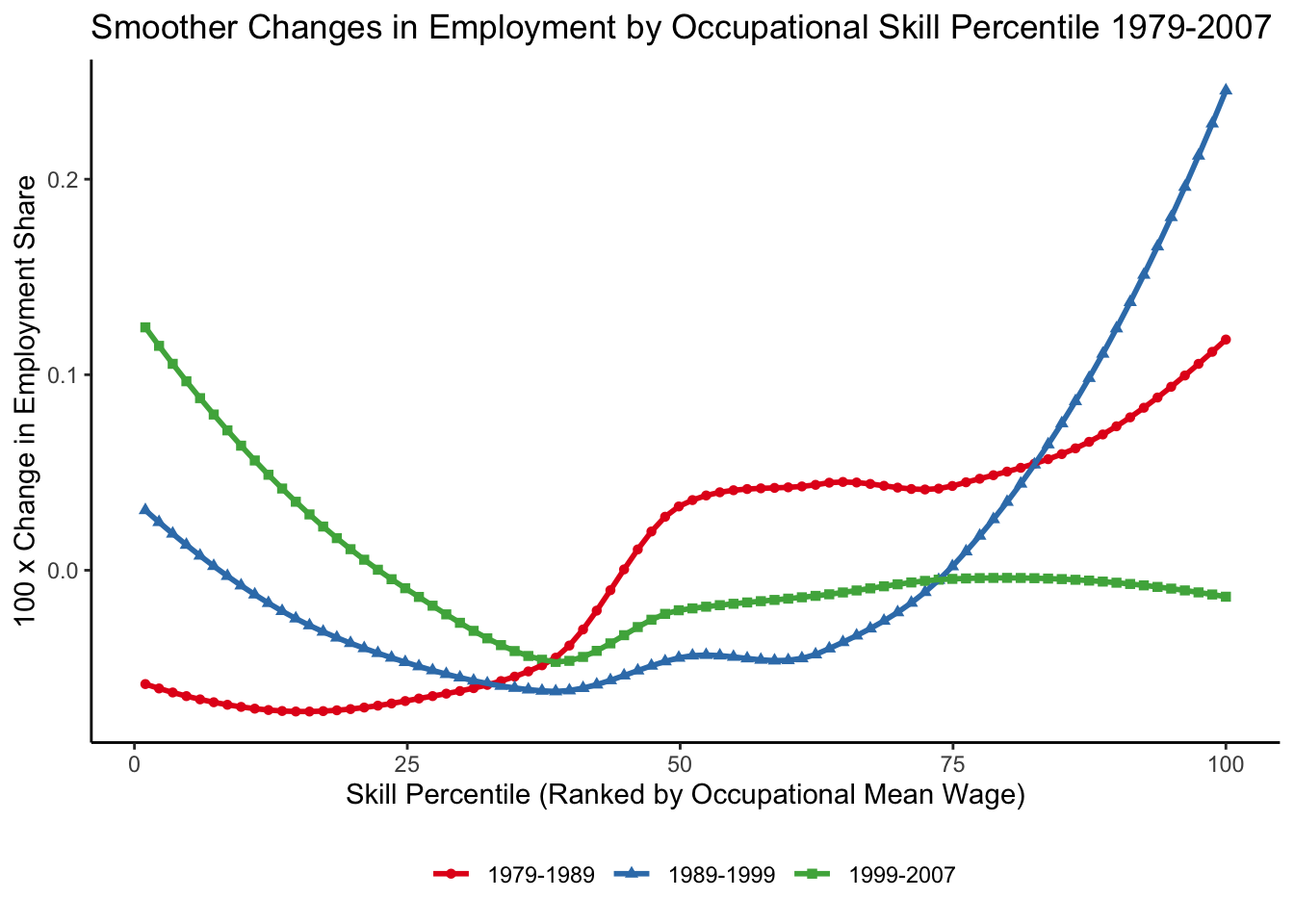
The canonical skill-biased technological change (SBTC) model also cannot explain the phenomenon of job polarization: wages and employments in low- or high-skilled jobs grow faster than in mid-skilled jobs. We need a model that explicitly incorporates tasks to be able to study these kinds of questions.
Task-based model
Task-based model
Overview
Task is a unit of work activity that produces output
Skill is a worker’s endowment of capabilities for performing tasks
Key features:
- Tasks can be performed by various inputs (skills, machines)
- Comparative advantage over tasks among workers
- Multiple skill groups
- Consistent with canonical model predictions
The crucial feature of task-based model is the separation between worker skill and job tasks. Here, tasks are specific units of work activities that need to be done to produce the output. For example, buying ingrediants, making a dough and baking a bun could be two tasks that describe the job of a baker. Worker’s skills allow her to do these tasks with varying level of competence. For example, worker A who is particularly skilled at econometrics might not be that good in baking a bun. If you think about it then you may conclude that worker skills are basically measures of their relative advantages. That is exactly how the task-based model is presented in Acemoglu and Autor (2011).
- This framework allows us to specify the production function such that a task can be produced by either a worker with some skills or machines (so, we could study labour-replacing technology).
- Since workers’ skills determine their relative advantage in doing any given task, we can also study endogenous allocation of workers to jobs.
- We can study job polarisation with this model (need to have at least 3 skill groups for that).
- Finally, this model is consistent with the canonical SBTC model. If we equate job tasks to worker skills, we will get the canonical SBTC model.
Task-based model
Production function
Unique final good
Three types of labour:
Fir simplicity, assume
We first begin by describing the production function. Now, an output
We assume there are three types of labour: high-skilled
The
Finally, the terms
For simpler illustration of the model, we assume that
Task-based model
Market clearing conditions
Continuously differentiable
The relative productivities are decreasing in
Task-based model
Equilibrium without machines
Note that boundaries
This gives rise to the substitution of skills across tasks
Given the way we described comparative advantages, we can make a conjecture that in equilibrium there are threshold tasks
- only
- only
- only
Since it is the firm that chooses these treshholds, we can study the substitution of skills across tasks in response to changes in the envirionment. For example, if a relative supply of
Task-based model
Law of one wage
Output price is normalised to 1
All tasks employing a given skill pay corresponding wage
Task-based model
Skill allocations
Given the law of one wage, we can show that
Task-based model
Endogenous thresholds: no arbitrage
Threshold task
Similarly, for
Using same logic as in Appendix: derivation of skill allocations, we know that
This equality is useful also to pin down the values of thresholds
Hence, the equations in the above slide.
Task-based model
Endogenous thresholds: no arbitrage
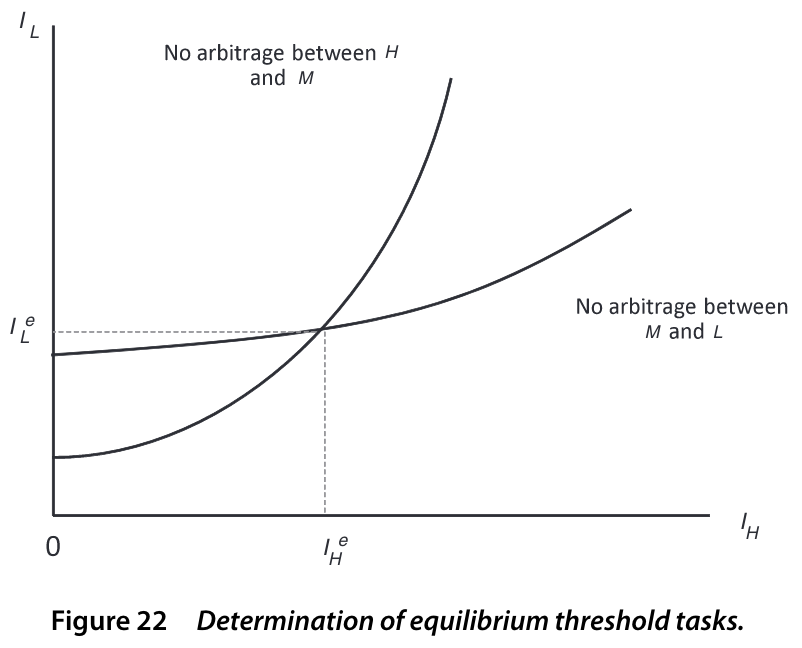
The equilibrium at the intersection because that’s when firm has no incentive to use
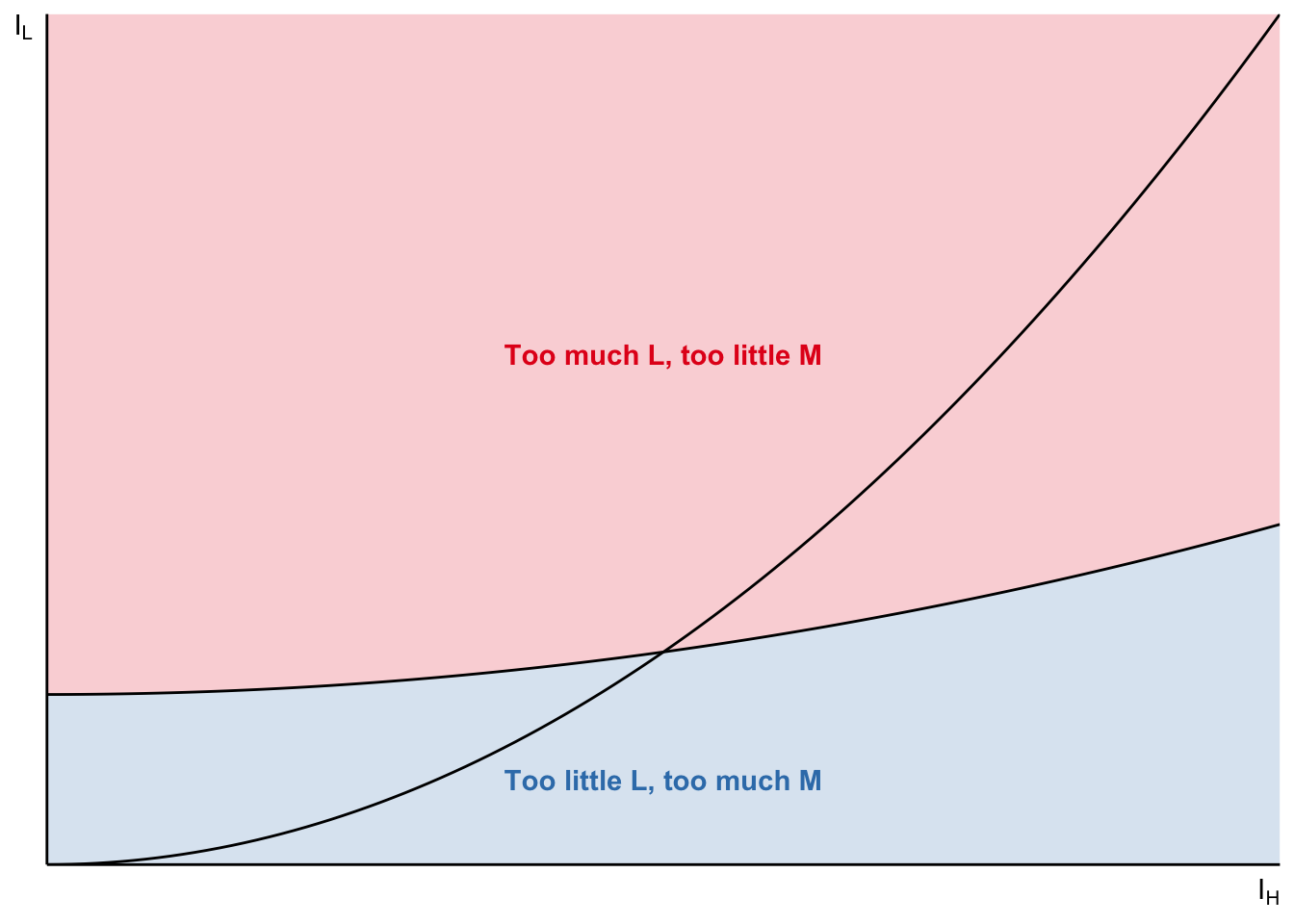
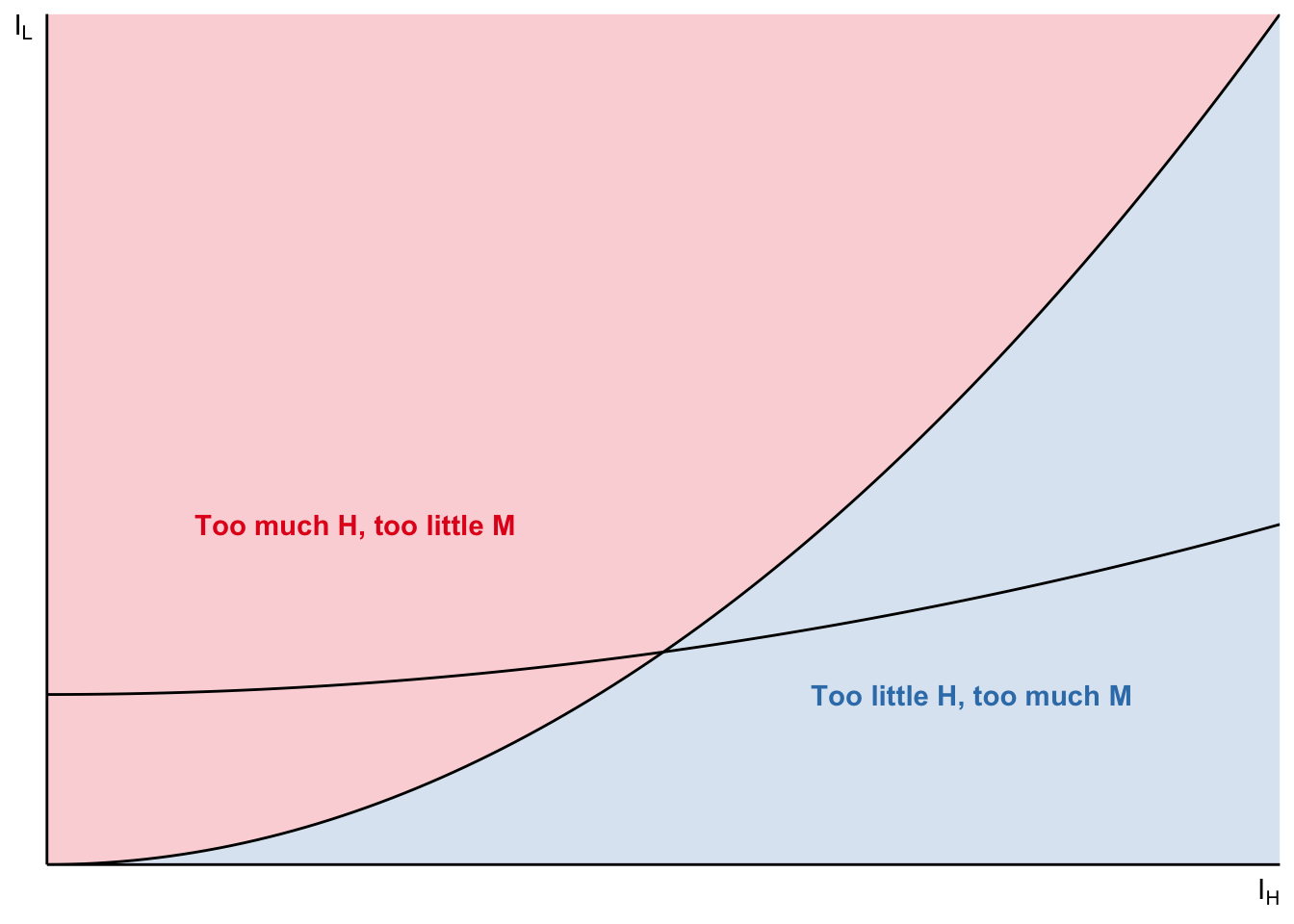
Task-based model
Comparative statics: wage elasticities
Task-based model
Comparative statics:
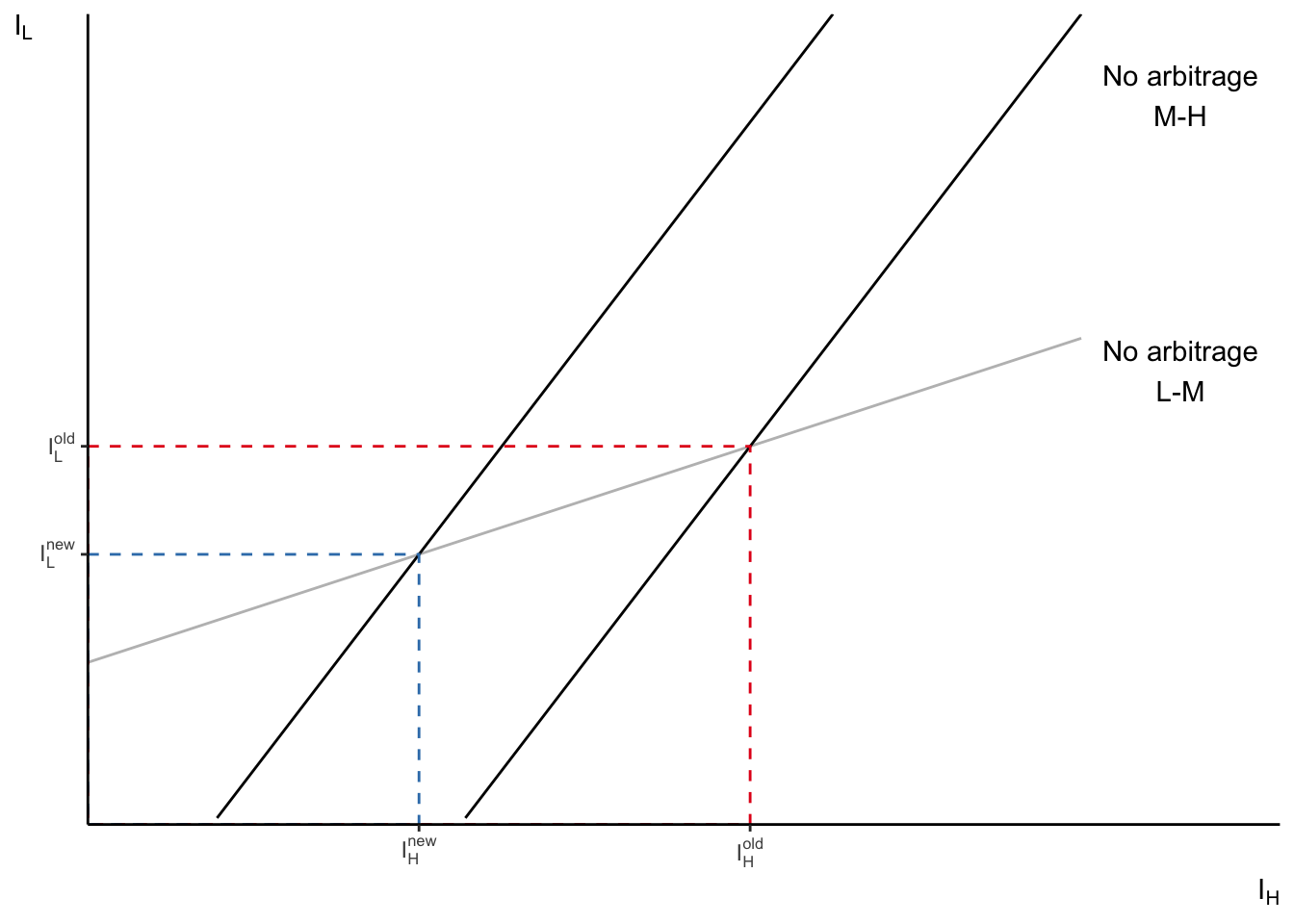
An increase in
- So, the firm wants to let
- This means that
- Since
- This also means that
- Overall, the wages of
Notice that the sign of the comparative statics with respect to change in
Unlike canonical model, changes in
Task-based model
Task replacing technologies
Start from initial equilibrium without machines

Assume in

How does it change the equilibrium?
Now, let’s consider what happens to the equilibrium when technological innovation is not factor-augmenting, but labour-replacing. In this example, we consider a case when machines can now out-perform
Let’s say the tasks that can be replaced by machines are in the interval
Task-based model
Task replacing technologies

Assume comparative advantage of

- Machines replace
- Now, the excess supply of
- Here, we assume that comparative advantage of
What does it mean for wages?
- We know that wages of
- We have argued above that
Thus, we can see how skill-replacing technological advancement can generate both
- fall in real wages, and
- disproportionate fall in
Task-based model
Endogenous supply of skills
Each worker
Workers allocate time to each skill given
Comparative advantage:
Then, there exist

So far, we have assumed inelastic labour supply, which gave us valuable insights. But to consider full implications of the technological changes, we need to take into account changes in the supply of skills. If the incentives changed such that
Consider some worker
Let’ assume, again for simplicity, that she has linear risk-neutral utility with no disutility of labour. Therefore, her utility is equivalent to her earnings
The labour supply, therefore, is
We also assume that workers have their comparative advantages in the three skill types. In particular, we impose an order on
Similar to the problem on the firm side, we can make a conjecture that an equilibrium in this model is described by two threshold values
Let’s try to reason now, how would endogenous supply react to labour-replacing technology from the previous slide.
It is also reasonable to assume, as we did on the previous slide, that the margin between
In this case, the total effect on employment of
Now, the over-supply of
So, with endogenous labour supply, we can come up with a reasonable set of assumptions for model parameters that generate disproportionate growth of employment and wages at the extremes of distribution. Employment and wages in the middle fall substantially, while employment and wages at the bottom and top increase (or don’t fall).
Of course, the full set of comparative statics is more difficult in this case and there are fewer clear predictions that the model can make. But it is still easy to see the potential of these type of models in explaining a wide set of patterns in the data. For more detailed discussion and derivations, check Section 4.6 in Acemoglu and Autor (2011)!
Task-based model
Illustration in the data
Suppose
Use occupational specialization at some
Descriptive regression informed by the model!
It is clear so far that a task and skills allocations are endogenously determined. So, if we try to estimate the relationship between jobs and wages in the observational data, we will not be able to uncover the model parameters. However, it may still prove to be a useful descriptive analysis.
Recall our comparative statics about
To track these kinds of changes, we can study the evolution of wages in three different sill groups. Suppose we have data with wages
We now need to define variables that capture the comparative advantages of workers in either
Thus, we can regress the
Task-based model
Illustration in the data
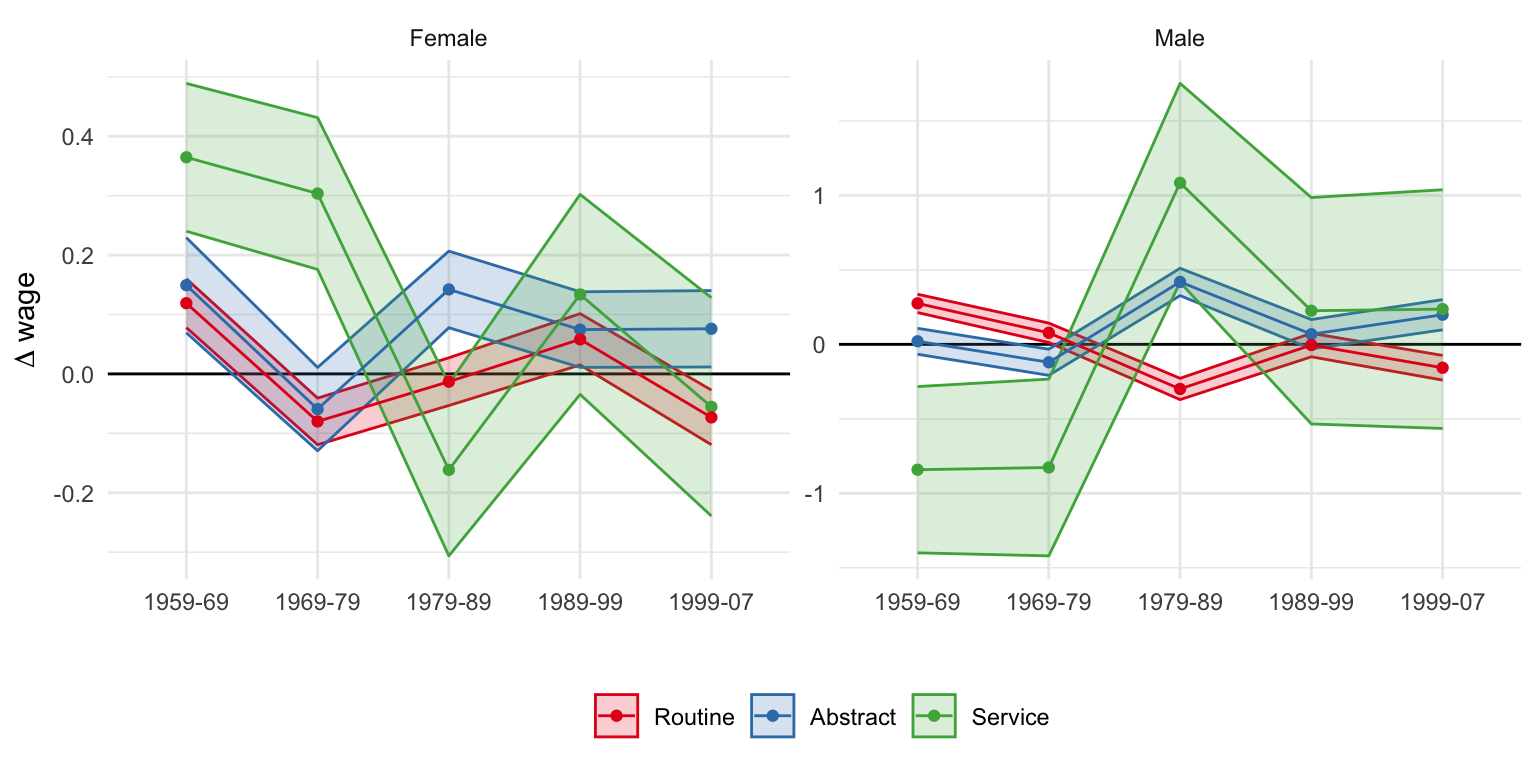
The figure above plots the regression results from Table 10 in Acemoglu and Autor (2011).
One common way of categorizing occupation is if they use abstract (
These results do provide some suggestive evidence that the task-based model can explain patterns seen in the data. However, this is highly descriptive: there is no exogenous variation of skill allocations of either workers or firms; the specialisations at
Task-based model
Summary
- A rich model that can accommodate numerous scenarios
- Outsourcing tasks to lower-cost countries
- Endogenous technological change
- Creation of new tasks
- Useful tool to study effect on inequality and job polarization
Empirical results
Acemoglu and Restrepo (2022)
Environment
Multi-sector model with imperfect substitution between inputs
(exposure to industryattribute 100% of the decline to automation
predict given industry adoption of automation technology
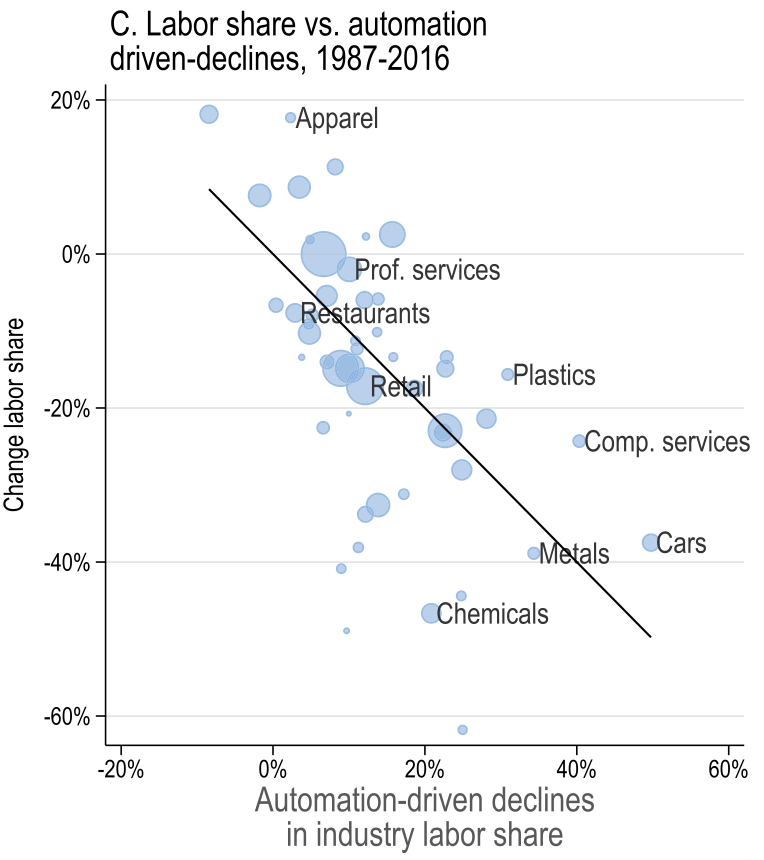
This is a more recent empirical study of the effect of task displacement technologies on employment and wages. The authors focus on period between 1980 and 2016 and construct task displacement index using initial industry specialisations and overall decline in labour share attributed to automation.
- The specialisations are constructed from industry-level. Some industries were hit harder by automation (for example, robotisation in manufacturing sectors) than others. So, authors use exposure of certain population group
- The automation is thought to mainly replace routine tasks. Therefore, worker groups that specialise in routine tasks are the one to be affected the most. Recall our discussion earlier in the lecture.
- Finally, we need a measure of how strongly automation affected a given industry over some period. The authors use decline in labour share and either attribute all of it to automation, or only part of it proportional to industry adoption of robotics.
Acemoglu and Restrepo (2022)
Task displacement
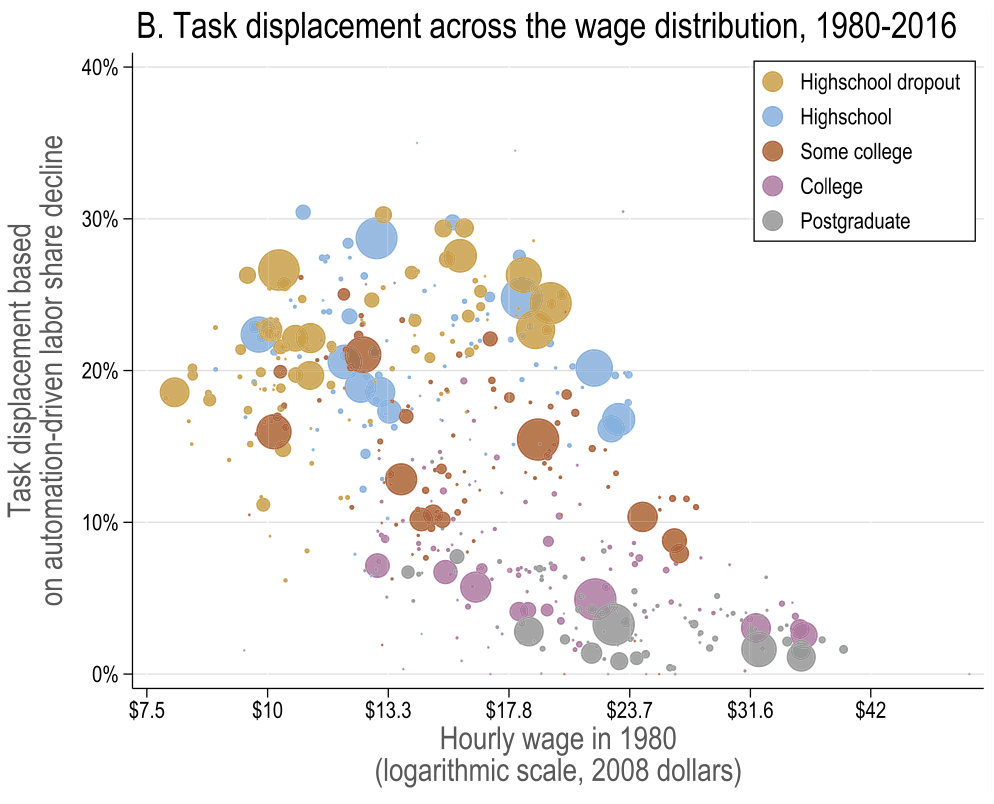
The above figure plots the task displacement index against initial wages by education group of workers. So, it is easy to see that lower-earning workers had higher exposure to task displacing technologies. But notice an inverse U-shape: it is mostly workers towards the middle of wage distribution that experienced largest displacement. We also see correlation with skill measures of workers: higher-education workers have lower task displacement indices even at similar wage levels. This is consistent with our theoretical discussion in Task replacing technologies.
Acemoglu and Restrepo (2022)
Task displacement and changes in real wages
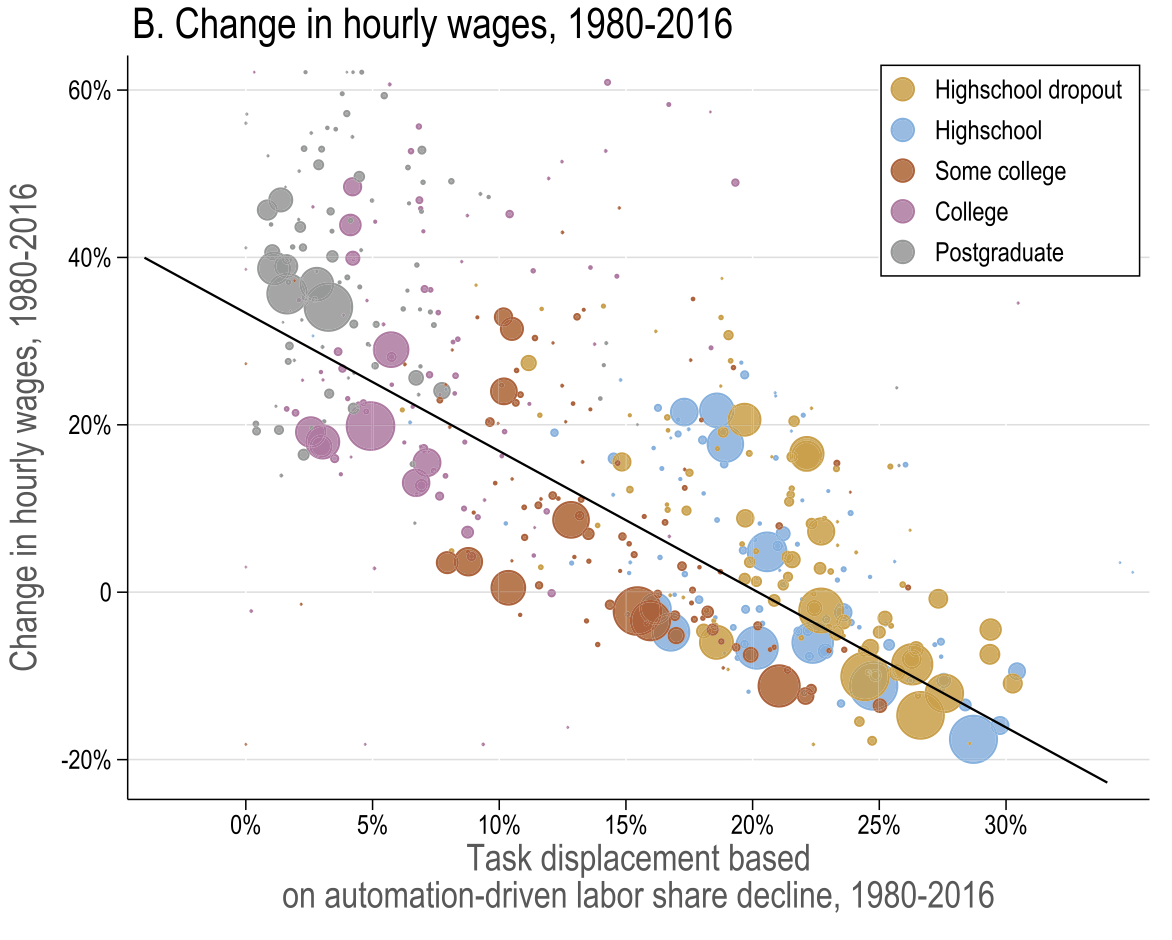
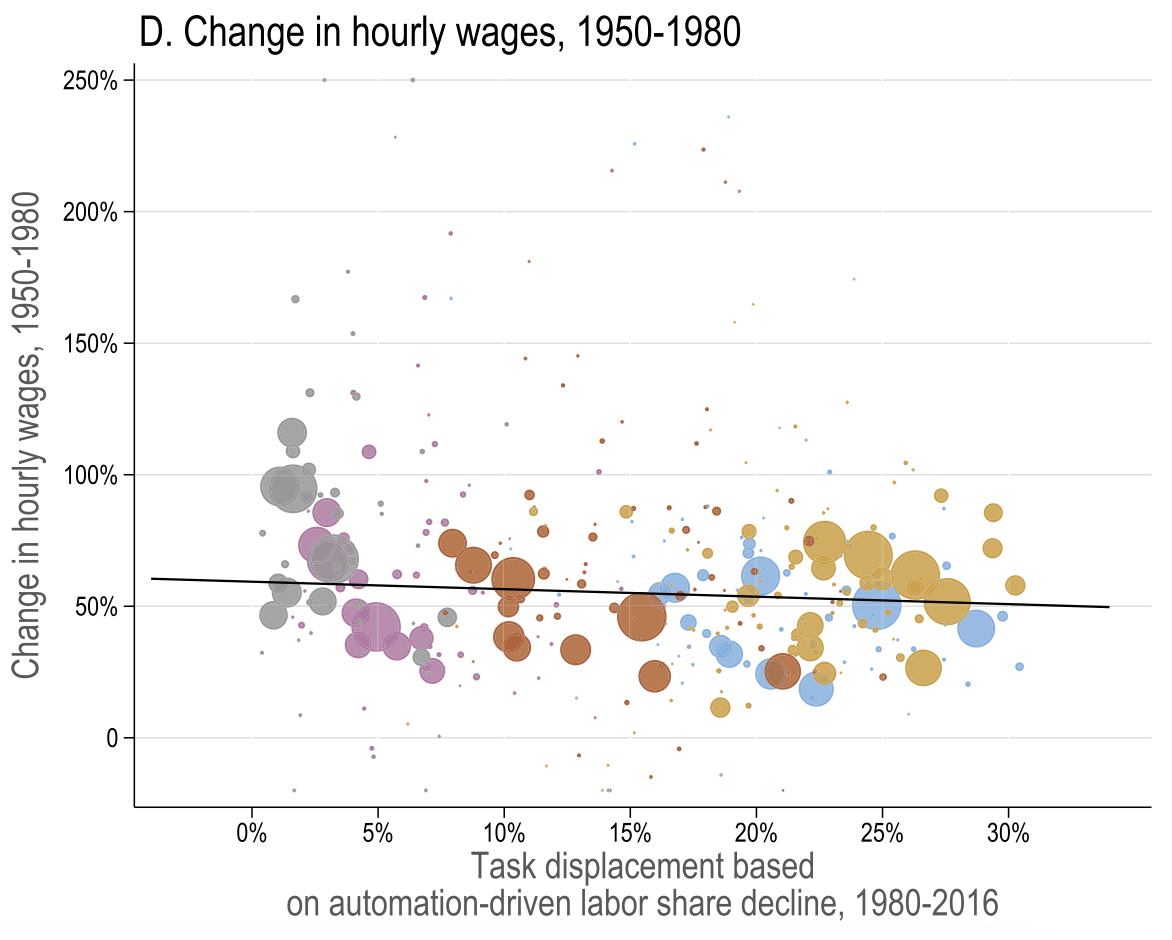
They verify these observations in a series of reduced form regressions. In particular,
50-70% of changes in wage structure are linked to task displacement and to a much smaller extent to offshoring
they conclude that SBTC without task displacement explains less of variation in the data
they ruled out alternative channels like
other non-automation capital
increase in capital use intensity
markups
industry concentration
unionization
and import competition
However, the reduced form estimates ignore general equilibrium. That is, it assumes
there is no endogenous adjustment of task thresholds at other margins (ripple effects)
no change in industry composition
doesn’t take into account productivity gains
Acemoglu and Restrepo (2022)
General equilibrium results
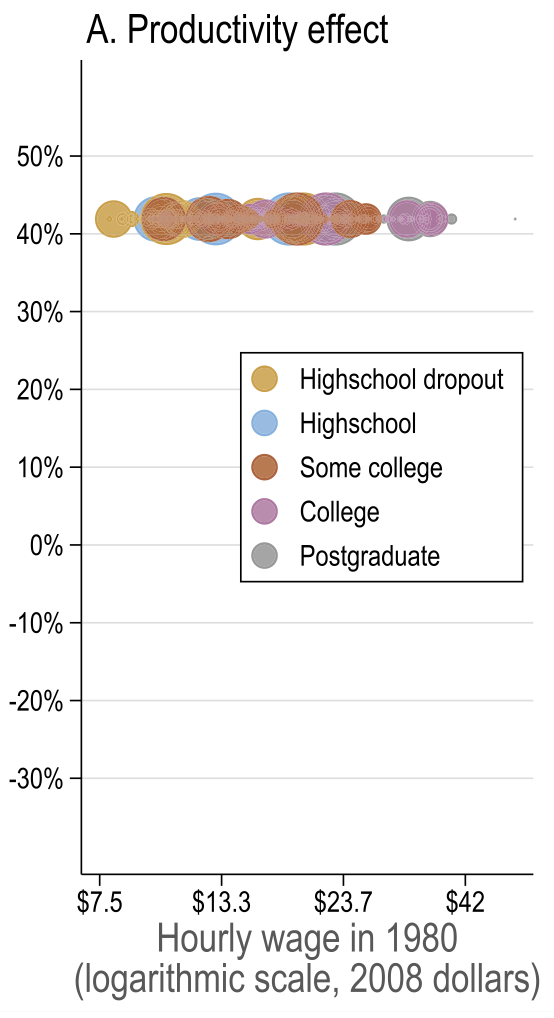
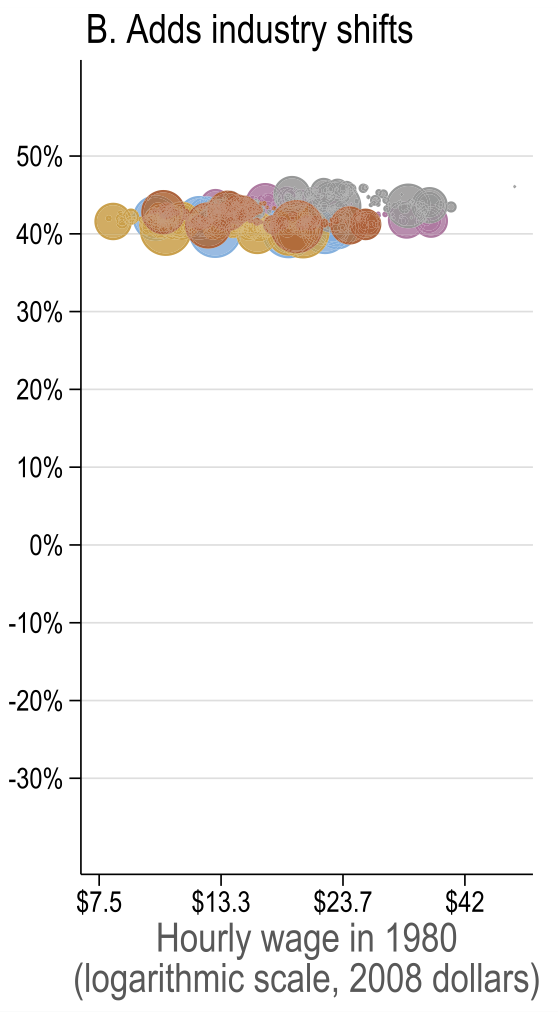
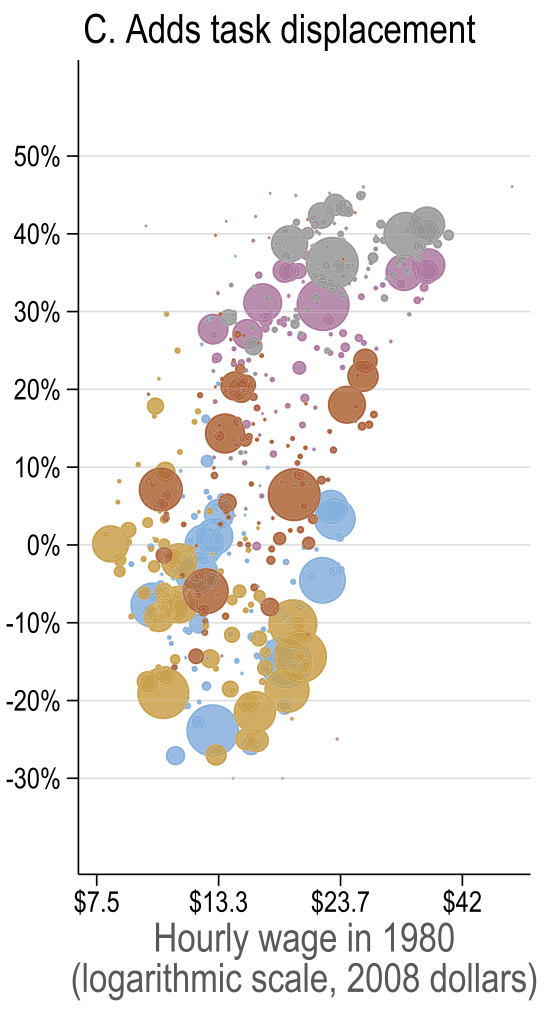
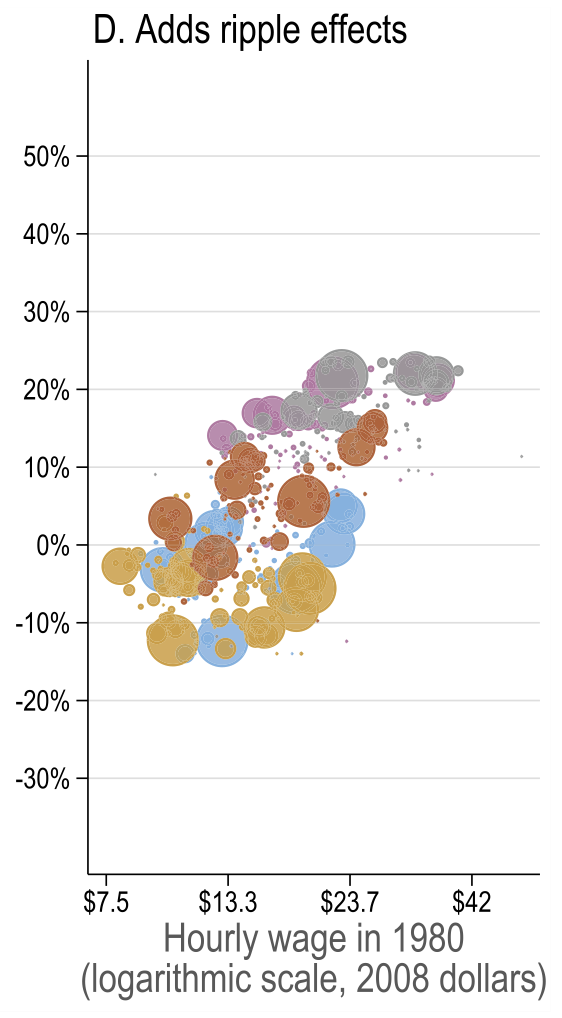
Source: Figure 7 (Acemoglu and Restrepo 2022)
- Common productivity effect
It’s when productivity improvement shifts supply of goods upwards meaning that output of firms goes up and as a result firm’s labour demand goes up as well for all labour categories. - Changes in industry composition induced by automation
Automation induces shift towards sectors with less automation, such as services
Account for <7% of observed changes in US wage structure - Direct task displacement
Explains up to 94% of observed changes in US wage structure, higher than reduced form estimates. The direct effect is larger because it does not allow the displaced workers to compete for tasks in other groups. The reduced form estimate did not control for it, hence it picked up some of the ripple effect. - Allowing for ripple effects
As expected, the magnitudes are lower because displaced workers start performing other group tasks and thus spread the effect across groups.
Acemoglu and Restrepo (2022)
Model fit
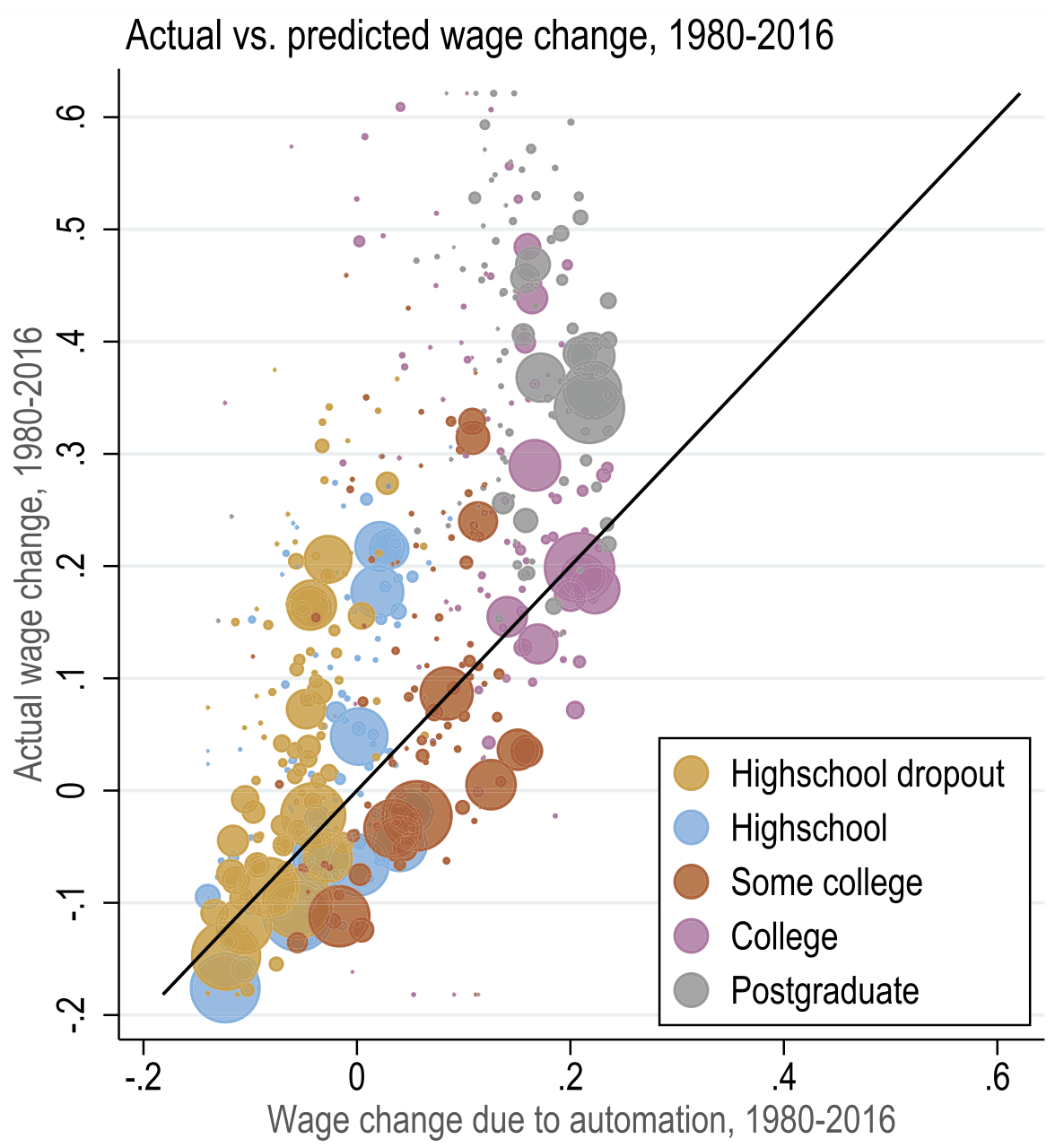
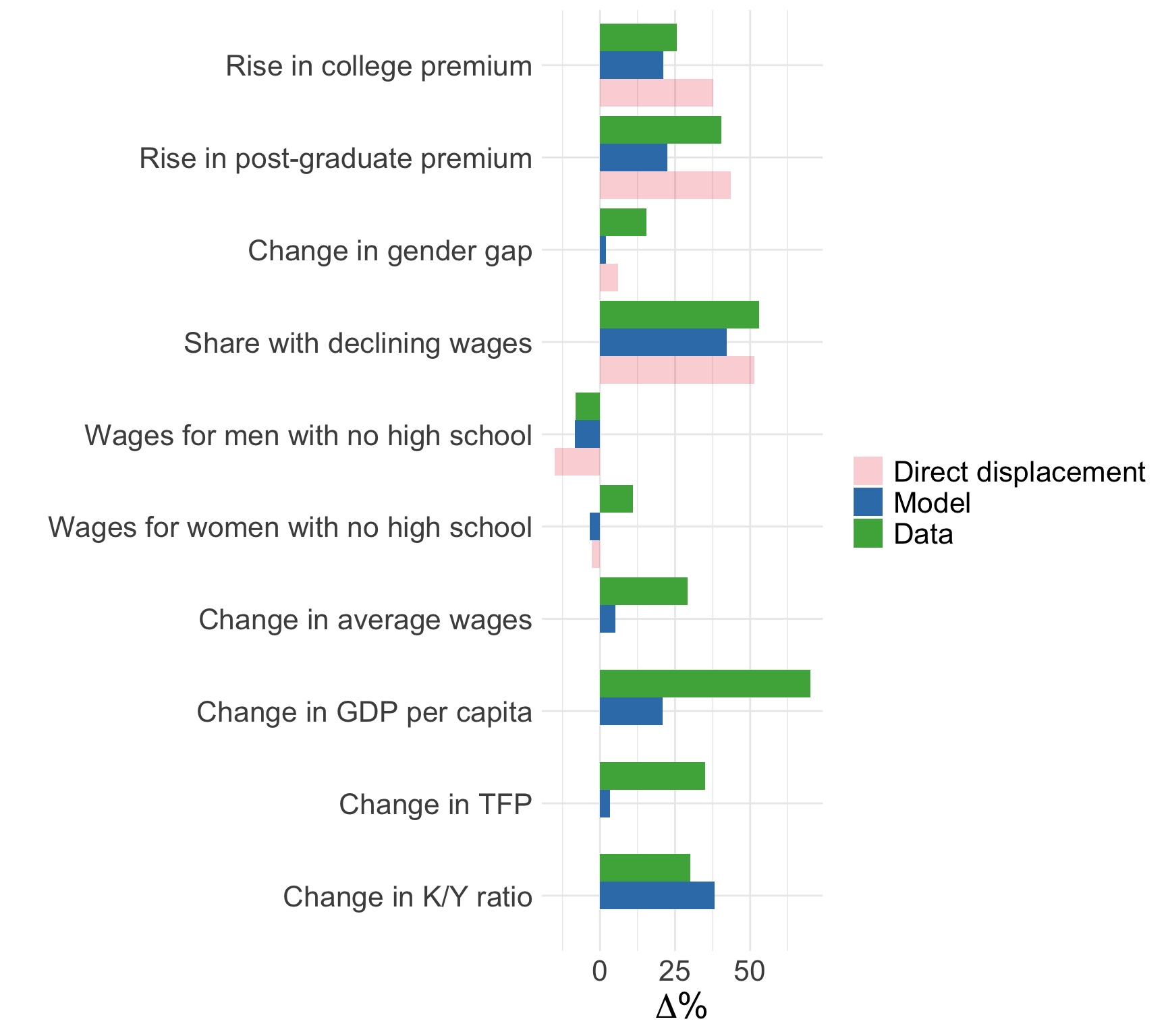
The model has close fit to the data everywhere except top of growth distribution
Technology-labour complementarity at the top
Different kinds of jobs (winner-takes-it-all)
Both absent from the model
It also predicts well changes in college premium and wages of men without high school
But it misses big on aggregate things like GDP and TFP
could indicate there were factor-augmenting tech shifts, productivity deepenings, or even new tasks
this wold affect wage levels, but would have little impact on inequality because have shown that inequality is largely attributed to automation
It also suggests that automation-induced investments in the model are in line with data
It also misses on wages of women, which could suggest that supply side ignored so far can also play an important role.
Summary
Two theories linking technological advancements and labour markets
Canonical model (SBTC)
- Simple application of two-factor labour demand theory
- Empirically attractive characterization of between-group inequality
- Fails to account for within-group inequality, polarization, and displacement
Task-based model (automation)
- Rich model linking skills to tasks to output
- Explains large share of changes in the wage structure since 1980s
Next lecture: Labour market discrimination on 22 Sep
Also mention that work continues because
adoption is itself an endogenous decision
creation of new tasks
labour supply adjustments
Appendix: derivation of wage equations
The firm problem is to choose entire schedules
We normalised
In equilibrium, all
Similar argument for
Let’s write out the profit-maximisation problem (already taking-into account
Take the first-order derivative with respect to
We can substitute the expression for
Now, imagine that marginal productivity of
Hence,
Notice that for any two tasks
Similar arguments for wages of
Appendix: derivation of skill allocations
Given the law of one price (wage) we can also write that
Given the Appendix: derivation of wage equations, it implies that
Plug it into the market clearing condition for
Similar argument for
We have concluded above that for any task
Let’s consider again the set of tasks given to
Rewrite it
Therefore, the
